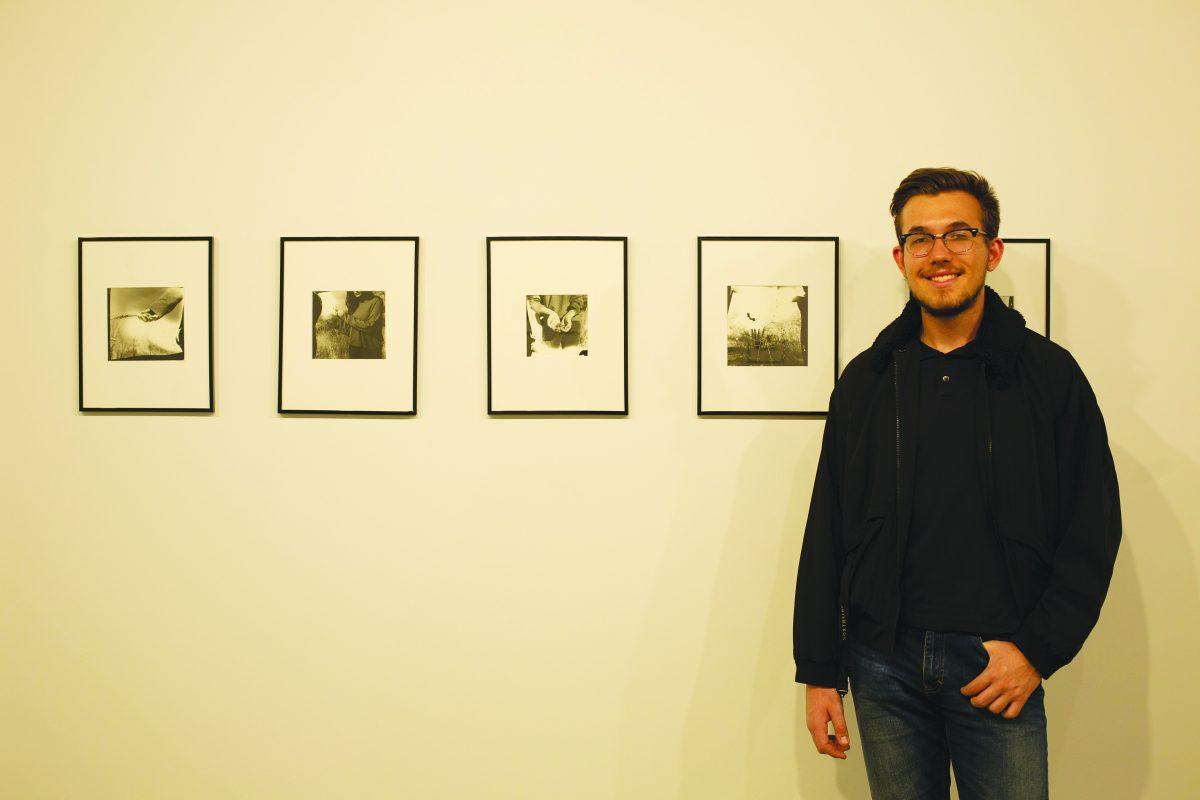A large white rectangular block stands in the middle of a large white room in the SP/N Gallery at Synergy Park North 2. One side is adorned by detailed cutout black and white pictures of mushrooms, and the other side covered with small framed black and white photos of smiling people covered with paint splatters and brush strokes.
On the walls surrounding this block are framed photos of burnt negatives and photos splattered with paint — the work of UTD alumna Kaitlyn Killian and chemistry junior Zachary Chroust as part of the “Experimental Methods” exhibit on display until April 26.
Chroust said he’s had a passion for dark room photography since high school, where he was introduced to it in a photography course he took for his fine arts requirement. After seven years of experience in the field, he felt prepared to be able to pull off his own show.
“I fell in love with it because it really truly is a fine art, and it’s amazing to be able to synthesize your own photograph in a way that’s unique to you and no one else can copy,” Chroust said. “Ever since then, it’s become more of a hobby and a passion for me. I absolutely love developing film and going to the dark room.”
Killian could not be reached for comment prior to publication.
Dark room photography consists of soaking negatives, or color inverted photos, in a diluted chemical solution and shining light on them to turn them into positives, where the colors are correctly reproduced to appear like what was captured. The process takes place in a room completely devoid of light to allow controlled projection of light and development of the photos.
People often don’t know enough about the level of precision and focus that goes into developing photos in the dark room, Chroust said.

“They think you can just run a piece of paper into a solution, but it’s more than that because you have so many things to control, and there’s a lot of places you can go wrong and putting the wrong chemistry into the development,” he said. “They don’t understand how much chemistry goes into it and how much money goes into it because it’s really expensive to keep this passion.”
Chroust worked on the pieces featured in the gallery as part of his final project last year and his independent study this year in photography professor Diane Durant’s class. He normally did traditional dark room photography, which involves developing black and white photos.
The photos taken and modified in the exhibit were made using non-traditional methods such as melting and burning the negatives, Brian Scott, the technical facilities manager for the School of Arts and Humanities, said.
“You could achieve all of this on a computer, too, which is also experimental photography, but I don’t think that’s the nature of Dr. Duran’s class,” Scott said. “We’re working in the dark room with these traditional materials, and we want to use the tools in the ways that aren’t conventional.”
Durant pushed Chroust and Killian to create their photography outside of conventional methods, which Chroust said he was used to.
“It makes me feel accomplished that it’s something so critical and difficult to accomplish,” Chroust said. “There’s so many parameters to each photograph and so many parameters to each negative you have to perfect.”
Setting up the show in the SP/N Gallery was a challenge itself, Chroust said. It was difficult at first to set up the space to accommodate the four series of works — two of which were his and two of which were Killian’s — and conform to a common theme.
“It was really hard for me and her to be able to move the walls around and be able to know what order it goes in,” he said.
Chroust said he hopes people walk away from the gallery with a greater understanding of dark room photography. As a pre-medical student, he couldn’t see himself being given the opportunity to feature the work he was passionate about in a gallery.
“I would really want people to understand the medium better and to see that there’s so many things that you can apply it to even if it’s not such a popular form of art to this day,” he said.







